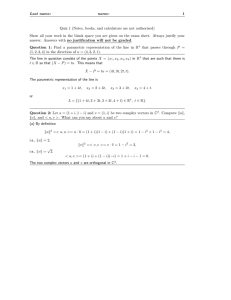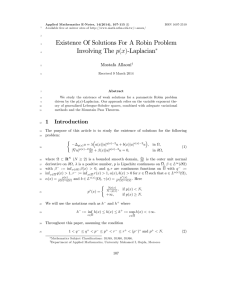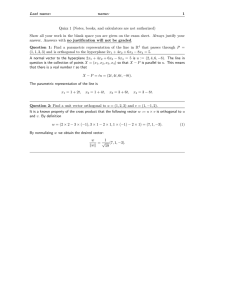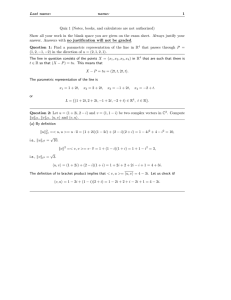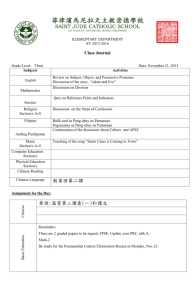Document 10677527
advertisement
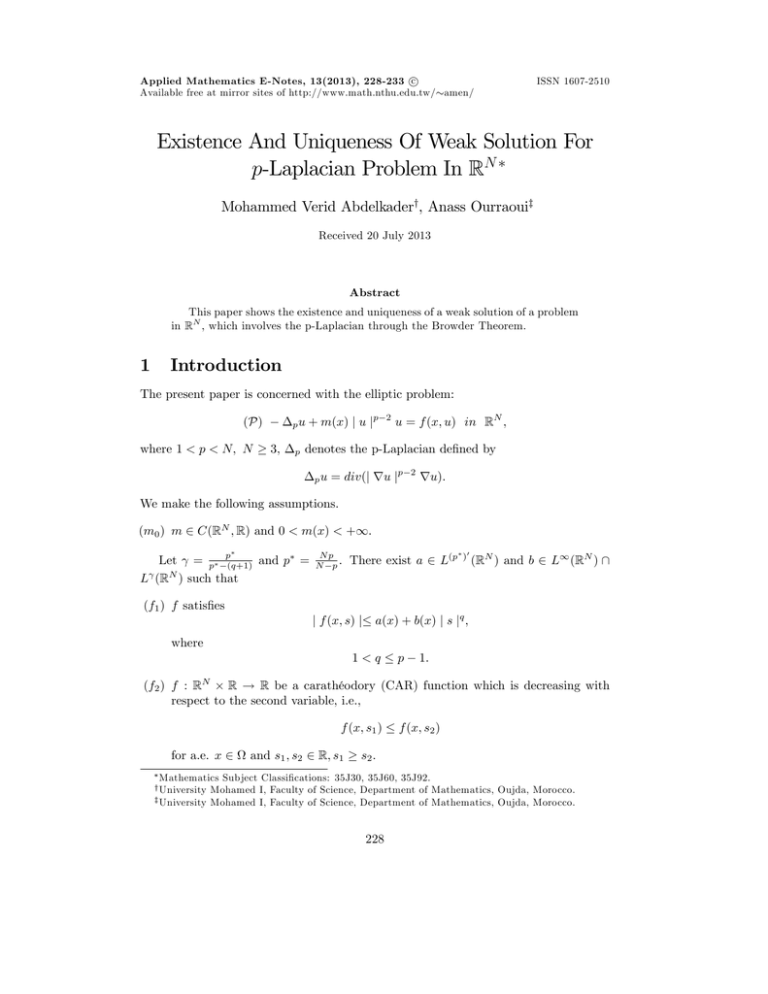
Applied Mathematics E-Notes, 13(2013), 228-233 c Available free at mirror sites of http://www.math.nthu.edu.tw/ amen/ ISSN 1607-2510 Existence And Uniqueness Of Weak Solution For p-Laplacian Problem In RN Mohammed Verid Abdelkadery, Anass Ourraouiz Received 20 July 2013 Abstract This paper shows the existence and uniqueness of a weak solution of a problem in RN ; which involves the p-Laplacian through the Browder Theorem. 1 Introduction The present paper is concerned with the elliptic problem: (P) where 1 < p < N; N pu 3, p + m(x) j u jp 2 u = f (x; u) in RN ; denotes the p-Laplacian de…ned by pu = div(j ru jp 2 ru): We make the following assumptions. (m0 ) m 2 C(RN ; R) and 0 < m(x) < +1: Let = p p(q+1) and p = L (RN ) such that Np N p. There exist a 2 L(p (f1 ) f satis…es j f (x; s) j )0 (RN ) and b 2 L1 (RN ) \ a(x) + b(x) j s jq ; where 1<q p 1: (f2 ) f : RN R ! R be a carathéodory (CAR) function which is decreasing with respect to the second variable, i.e., f (x; s1 ) for a.e. x 2 and s1 ; s2 2 R; s1 f (x; s2 ) s2 : Mathematics Subject Classi…cations: 35J30, 35J60, 35J92. Mohamed I, Faculty of Science, Department of Mathematics, Oujda, Morocco. z University Mohamed I, Faculty of Science, Department of Mathematics, Oujda, Morocco. y University 228 M. V. Abdelkader and A. Ourraoui 229 The goal of this paper is to prove the following result: THEOREM 1. Assume that (m0 ) holds and f 2 CAR(RN (f2 ): Then the problem (P) has a unique weak solution. R) satis…es (f1 ) and When p = 2, the problem (P) is a normal Schrodinger equation which has been extensively studied. There are several studies of the existence of solutions of (P) on a bounded domain of RN : We mention the results obtained in [1, 2] and [6] for the case of bounded domains. In recent years, more and more attention is paid to the quasilinear elliptic setting on RN : The main di¢ culty in the study of p-Laplacian equations in RN arises from the lack of compactness. In the squeal, we recall some basic de…nitions and notations which will be used throughout the paper. Whereas, the last part of the article is dedicated to the demonstration of our main result. DEFINITION 1.We say that u 2 W 1;p (RN ) is a weak solution of problem (P) if Z Z Z p 2 p 2 jruj rurvdx + m(x) juj uvdx = f (x; u)vdx RN RN RN for all v 2 W 1;p (RN ): For simplicity let X = W 1;p (RN ): According to condition (m0 ); we can introduce a new norm de…ned as follows k u k= Z p RN jruj dx + Z p RN m(x) juj dx 1 p : DEFINITION 2. Let K be a Banach space. An operator A : K ! K veri…es hAu Av; u vi 0 (1) for any u; v 2 K is called a monotone operator. An operator A is called strictly monotone if for u 6= v the strict inequality holds in (1). An operator A is called strongly monotone if there exists C > 0 such that hAu Av; u vi Cku v k2 for any u; v 2 K: We recall Browder Theorem. Theorem 3 (cf. [3]). Let A be a re‡exive real Banach space. Moreover, let A : X ! X be an operator which is: bounded, demicontinuous, coercive, and monotone on the space X . Then, the equation A(u) = f has at least one solution u 2 X for each f 2 X : If moreover, A is strictly monotone operator, then the equation (P) has precisely one solution u 2 X for every f 2 X : 230 Existence and Uniqueness of Solution for p-Laplacian Problem We de…ne the operator A : X ! X by A := I F; where the operators I and F are de…ned from X into X as Z Z p 2 p hI(u); vi = jruj rurvdx + m(x) juj RN 2 uvdx RN and hF (u); vi = Z f (x; u)vdx; RN for all u; v 2 X: By De…nition 1, the main tool in searching the weak solutions of (P) is to …nding u 2 X which satis…es the operator equation Au = 0: 2 Proof of The Main Result We denote by C and Ci ; i = 1; 2::: the general positive constants which are the exact values may change from line to line. PROOF OF THEOREM 1. In order to apply Browder Theorem, we split the proof in several steps, Step1. We prove that A is bounded. We know that the functional Z 1 p p (jruj + m(x) juj ) dx (u) = p N R is of class C 1 (cf. [5]) and I is the derivative operator of in the weak sense, so it yields I is bounded and continuous. Let u 2 X; such that k u k< K. Using Hölder’s inequality, we obtain kF (x; u)kX = sup j hF (x; u); vi j kvk=1 sup kvk=1 sup Z RN a(x) jvj dx + 8 < Z kvk=1 : sup kvk=1 a(p dx q RN 1 (p )0 b(x) juj jvj dx + RN (" Z C3 kak(p ) 0 Z RN (p )0 a dx 1 (p )0 RN )0 Z + C4 K q kbk ; hence A is bounded. + Z juj RN q p p dx Z p (bv) p q p p q dx RN p juj q p dx Z RN b 1 # Z RN 9 = ; p jvj 1 p dx ) M. V. Abdelkader and A. Ourraoui 231 Step 2. We prove that A is demicontinuous. It is well known that the functional Z 1 p p (jruj + m(x) juj dx (u) = p RN is of class C 1 : Since I is the Fréchet derivative of hence I is continuous. Now we check that F is completely continuous that is, if un * u then F (un ) ! F (u) and it is well be done. Let un is weakly convergent to u in X so un is bounded in X. Set Bk = x 2 RN : jxj < k ; so we have jbjL Z (RN nBk ) RN nBk converges to zero as n ! +1. For all v 2 X we have Z a(x) jvj dx jvj RN nBk C kvk p dx Z ! p1 Z RN nBk 0 (p ) RN nBk (p )0 jaj dx ! jaj dx ! 1 (p )0 1 (p )0 : Similarly, Z Z q RN nBk b(x) juj jvj dx RN nBk Z RN nBk juj p juj p q C kuk kvk ! pq Z dx ! pq Z RN nBk Z (b(x) jvj) p RN nBk b(x) dx RN nBk ! p1 p jvj !1 p q Z dx ! pp b RN nBk q !1 : According to previous inequalities we have, Z (f (x; un ) f (x; u))vdx RN nBk C kvk Z b(x) dx RN nBk !1 +kvk Z RN nBk ja(x)j 0 (p ) which yields that Z (f (x; un ) RN nBk f (x; u))vdx ! 0 for k su¢ ciently large. From the compact embedding W 1;p (Bk ) ,! Lq (Bk ), we can infer that Z Z f (x; un )vdx ! f (x; u)vdx Bk Bk ! dx 1 (p )0 ; 232 Existence and Uniqueness of Solution for p-Laplacian Problem and then we have Z (f (x; un ) RN Z + (f (x; un ) Bk f (x; u))vdx Z = (f (x; un ) f (x; u))vdx RN nBk f (x; u))vdx ! 0: So F is completely continuous and then F is continuous. Step 3. We prove that A is monotone. We recall the following inequality for p x; y 2 RN (see [4]) jyj p p p 2 jxj + p jxj x(y x) + 2; p jy 2p xj : 1 1 p 2 rv (ru Let hI(u) I(v); u vi = Z RN + Z jruj p 2 rudx p 2 m(x)(juj RN u jrvj p 2 jvj v)(u rv)dx v)dx: We obtain that hI(u) I(v); u vi 2 p2p 1 = Cp ku Z 1 RN p vk : jru p rvj dx + Z RN m(x) ju p vj dx (2) Therefore, A is strongly monotone. ( see e.g. [7]). Further, since f is decreasing with respect to the second variable, Z hF (u) F (v); u vi = (f (x; u) f (x; v))(u v)dx 0: RN It follows that A is strongly monotone. Step 4. We prove that A is a coercive operator. We have Z Z 1 1 p p hAu; ui = (jruj + m(x) juj ) dx f (x; u)udx kuk kuk RN RN Z 1 p q kuk (a(x) juj + b(x) juj juj)dx kuk RN 1 p kuk C1 kak(p )0 kuk C2q+1 kuk kuk ; kuk which yields the coercivity of A for 1 < q < p 1: In the case when q = p 1; since X ,! Lp (RN ) with continuous embedding, then by a similar argument to that used in [1], A is coercive. Step 5. From the previous steps, the assumptions of Theorem 3 are ful…lled. Therefore, problem (P) has a weak solution. For the uniqueness of weak solution for M. V. Abdelkader and A. Ourraoui 233 problem (P); suppose that u and v be a weak solutions of (P) such that u 6= v. By (2) it follows that 0 = hAu Av; u vi Cp ku p vk 0: Then u = v and the proof now is completed. This solution cannot be trivial provided that we suppose f (x; 0) 6= 0; because in this case A0 6= 0: Acknowledgment. The authors would like to thank the anonymous referee for the valuable comments. References [1] G. A, Afrouzi, S. Mahdavi, and Z. Naghizadeh, Existence and uniqueness of solution for p-Laplacian dirichlet problem, Int. J. Nonlinear Sci., 8(2009), 274–278. [2] S. Khafagy, Existence and uniqueness of weak solution for weighted p-Laplacian Dirichlet problem, J. Adv. Res. Dyn. Control Syst., 3(2011), 41–49. [3] J. Leray, J. L. Lions, Quelques resultats de Visik sur les problems elliptiques nonlineaires par les methodes de Minty Browder, Bull. Soc. Math. France, 93(1965), 97–107. [4] P. Lindqvist, On the equation div(jrujp Soc., 109(1990), 157–164. 2 ru) + jujp 2 u = 0; Proc. Amer. Math. [5] M. Mihailescu and V. Radelescu, A multiplicity for a nonlinear degenerate problem arising in the theory of electrorheological ‡uids, Proc. Roy. Soc. London Ser. A, 462(2006), 2625–2641. [6] J. S. W. Wong, On the generalized Emden-Fowler equation, SIAM Rev., 17(1975), 339–360. [7] E. Zeidler, Nonlinear Functional Analysis and Its Applications, Vol. I, II/A, II/B, III and IV, Springer Verlag, Berlin, Heidelberg, New York, (1986).



